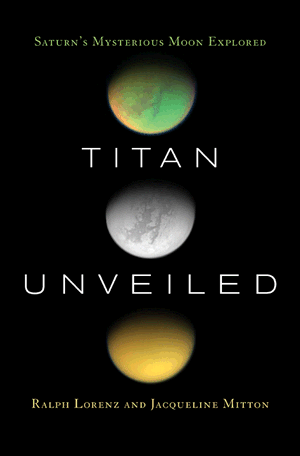[/caption]
Take a layer off a Matryoshka doll and you find more of the same. Try to answer questions about a mysterious satellite of Saturn and more questions come bubbling up to the surface. Ralph Lorenz and Jacqueline Mitton in their book “Titan Unveiled – Saturn’s Mysterious Moon Explored” treat the reader to this common scientific dilemma. In it, we see that the recent Cassini-Huygens mission gave us many answers to many questions but leaves a whole lot more just awaiting.
The tiny moon Titan orbits its giant mother planet Saturn. Our distant Sun shines so dimly at its distance that it can have no appreciable effect. But, some unidentified source of energy effects Titan’s surface. We know this because of the spectacular terrain that’s eerily evocative of Earth. Coastlines, volcanic mounts and great sand dunes appear to grace every view. This apparently dynamic surface may lead to other terrestrial similarities and may point to terrestrial analogues. This potential gave rise to the mission to Saturn and, in its own way, to this book.
This book has three intermingling tracts: Titan and its physical details, the Cassini-Huygens mission, and an author’s personal travails with the mission and space exploration. The Titan tract includes a review of the growth of knowledge regarding this moon. Particularly, there’s concepts drawn from the Voyageur probes as well as space based and land based telescopes. These include the magnetosphere, atmosphere and surface reflectivity. The accumulated knowledge is shown to be a necessary precursor to the mission and in particular to the Huygens lander.
The second tract looks at the Cassin-Huygens mission, its history, funding, scientific payload and initial arrival at the Saturn system. The writing is current to about July 2006, or Cassini orbit T16. Though the book has some well-known detail, such as the scientific payload, for the most part it looks at the processes, whether the need for continual political support, constant adaptation to modifications and the need for patience during the long flight out. These are interesting but don’t really pertain to the unveiling of Titan.
Sections that have sub-titles such as “Ralph’s Log, August 1994” easily identify the third tract. These also seem out of place as they exhibit a more personal interest rather than a exposition of Titan. In the logs are descriptions of breaking into rooms, threading wires through instruments and traveling to conferences. While adding a distraction, they may or may not be to the reader’s liking.
These three tracts constitute the majority of the book and also exhibit the book’s main weakness. That is, rather than unveiling Titan to the average reader, it is a personal narrative regarding a personal interest. Further, by finishing the writing before the end of the Cassini-Huygens mission, the reader should wonder, “why now, what’s the rush, what’s been left out?” Also diminishing the book are the many but small images. Though some have fantastic shapes, such as one of the cat’s claws at the feature Shikoku, they’re usually quite small and don’t do justice to the concept of unveiling. Thus, though entertaining, the book never really unveils Titan in a succinct manner.
This book does excel as a personal narrative of a scientist’s involvement in one of our grandest research endeavours. Equally, it will well satisfy someone who’s interested in the background of the Cassini-Huygen mission and especially the early results from its view of Titan. But, I expect that those who want a greater amount of detail of Titan will need other, more academic sources to obtain a better reference.
We are only beginning to appreciate the many interdependent physical properties that exist on Earth. Yet, we see similarities wherever we look. The book “Titan Unveiled – Saturn’s Mysterious Moon Explored” by Ralph Lorenz and Jacqueline Mitton shows how advancing our knowledge of a distant satellite that orbits a distant planet has provided a special benefit to us on Earth.
Click here to read more reviews or buy this book from Amazon.com.

